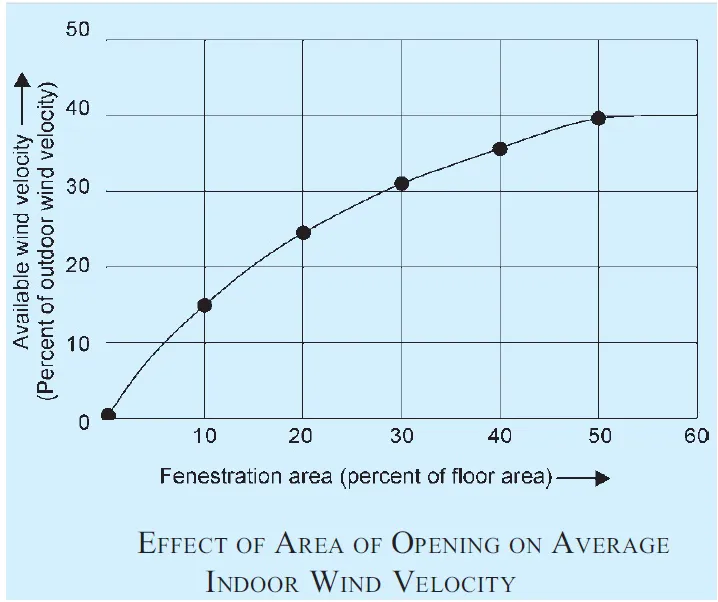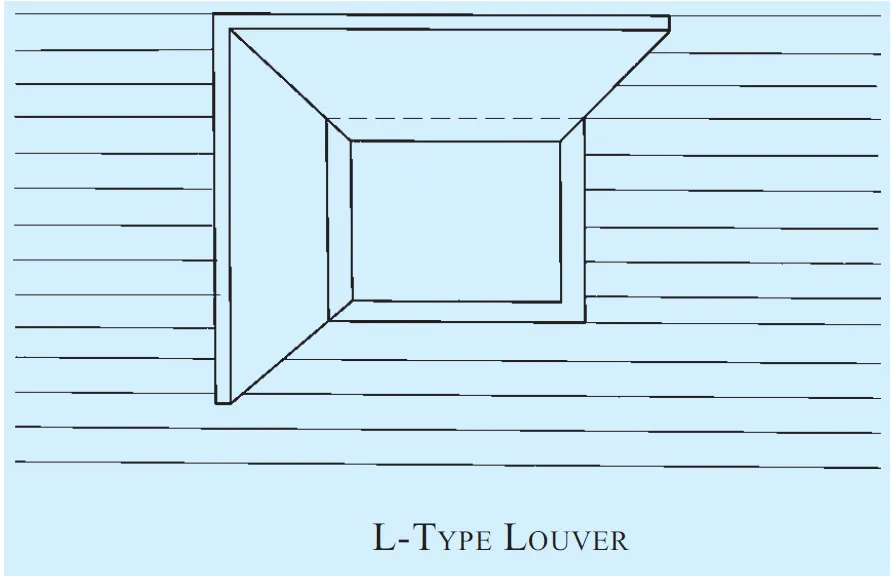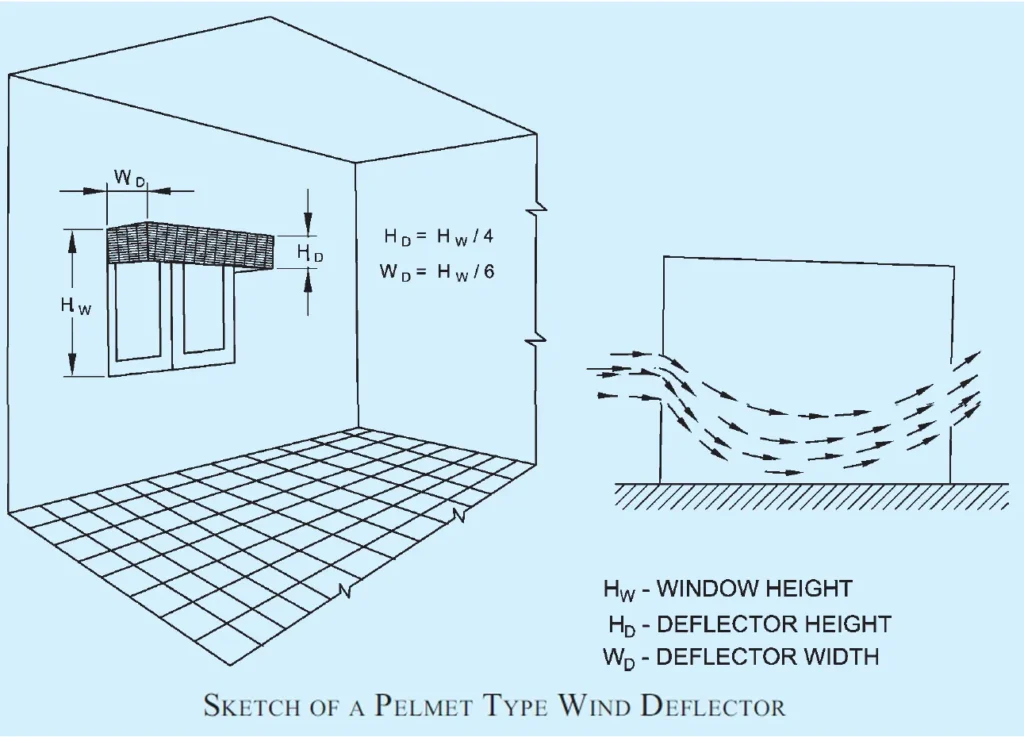If you want to know about the scale and proportion in architecture or design consideration for HVAC or installation of split air conditioners, please click the link.
Designing for natural ventilation can be a great way to create comfortable and healthy indoor environments while minimizing energy consumption. Designers can create buildings that not only provide natural ventilation but also take into account local climate conditions, occupant comfort, and long-term maintenance.

Here are some guidelines for designing buildings for natural ventilation:
By wind action (Natural ventilation)
i) Point No. – 1
- A building need not necessarily be oriented perpendicular to the prevailing outdoor wind; it may be oriented at any convenient angle between 0° and 30° without losing any beneficial aspect of the breeze.
- If the prevailing wind is from East or West, building may be oriented at 45° to the incident wind so as to diminish the solar heat without much reduction in air motion indoors.
ii) Point No. – 2
- Inlet openings in the buildings should be well distributed and should be located on the windward side at a low level, and outlet openings should be located on the leeward side.
- Inlet and outlet openings at high levels may only clear the top air at that level without producing air movement at the level of occupancy.
iii) Point No. – 3
Maximum air movement at a particular plane is achieved by keeping the sill height of the opening at 85 percent of the critical height (such as head level) for the following recommended levels of occupancy:
- For sitting on chair 0.75 m,
- For sitting on bed 0.60 m, and
- For sitting on floor 0.40 m.
iv) Point No. – 4
- Inlet openings should not as far as possible be obstructed by adjoining buildings, trees, sign boards or other obstructions or by partitions inside in the path of air flow.
v) Point No. – 5
- In rooms of normal size having identical windows on opposite walls the average indoor air speed increases rapidly by increasing the width of window up to two-third of the wall width; beyond that the increase is in much smaller proportion than the increase of the window width.
- The air motion in the working zone is maximum when window height is 1.1m.
- Further increase in window height promotes air motion at higher level of window but does not contribute additional benefits as regards air motion in the occupancy zones in buildings.
vi) Point No. – 6
- Greatest flow per unit area of openings is obtained by using inlet and outlet openings of nearby equal areas at the same level.
vii) Point No. – 7
- For a total area of openings (inlet and outlet) of 20 percent to 30 percent of floor area, the average indoor wind velocity is around 30 percent of outdoor velocity.
- Further increase in window size increases the available velocity but not in the same proportion as shown in Figure below.

- In fact, even under most favorable conditions the maximum average indoor wind speed does not exceed 40 percent of outdoor velocity.
viii) Point No. – 8
- Where the direction of wind is quite constant and dependable, the size of the inlet should be kept within 30 to 50 percent of the total area of openings and the building should be oriented perpendicular to the incident wind.
- Where direction of the wind is quite variable the openings may be arranged so that as far as possible there is approximately equal area on all sides.
- Thus, no matter what the wind direction be, there would be some openings directly exposed to wind pressure and others to air suction and effective air movement through the building would be assured.
ix) Point No. – 9
- Windows of living rooms should open directly to an open space.
- In places where building sites are restricted, open space may have to be created in the buildings by providing adequate courtyards.
x) Point No. – 10
- In the case of rooms with only one wall exposed to outside, provision of two windows on that wall is preferred to that of a single window.
xi) Point No. – 11
- Windows located diagonally opposite to each other with the windward window near the upstream corner give better performance than other window arrangements for most of the building orientations.
xii) Point No. – 12
- Horizontal louvers, that is, sunshades atop windows deflect the incident wind upward and reduce air motion in the zone of occupancy.
- A horizontal slot between the wall and horizontal louver prevents upward deflection of air in the interior of rooms.
- Provision of inverted L type (G) louver increases the room air motion provided that the vertical projection does not obstruct the incident wind (see Figure below).

xiii) Point No. – 13
- Provision of horizontal sashes inclined at an angle of 45° in appropriate direction helps to promote the indoor air motion.
- Sashes projecting outward are more effective than projecting inward.
xiv) Point No. – 14
- Air motion at working plane 0.4 m above the floor can be enhanced by 30 percent using a pelmet type wind deflector (see Figure below).

xv) Point No. – 15
- Roof overhangs help promoting air motion in the working zone inside buildings.
xvi) Point No. – 16
- In case of room with windows on one wall, with single window, the room wind velocity inside the room on the windward side is 10 percent of outdoor velocity at points up to a distance of one-sixth of room width from the window and then decreases rapidly and hardly any air movement is produced in the leeward half portion of the room.
- The average indoor wind velocity is generally less than 10 percent of outdoor velocity.
- When two windows are provided and wind impinges obliquely on them, the inside velocity increases up to 15 percent of the outdoor velocity.
xvii) Point No. – 17
- Cross ventilation can be obtained through one side of the building to the other, in case of narrow buildings with the width common in the multistoreyed type by the provision of large and suitably placed windows or combination of windows and wall ventilators for the inflow and outflow of air.
xviii) Point No. – 18
- Verandah open on three sides is to be preferred since it causes an increase in the room air motion for most of the orientations of the building with respect to the outdoor wind.
xix) Point No. – 19
- A partition placed parallel to the incident wind has little influence on the pattern of the air flow, but when located perpendicular to the main flow, the same partition creates a wind shadow.
- Provision of a partition with spacing of 0.3 m underneath helps augmenting air motion near floor level in the leeward compartment of wide span buildings.
xx) Point No. – 20
- Air motion in a building unit having windows tangential to the incident wind is accelerated when another unit is located at end-on position on downstream side (see Figure below).

xxi) Point No. – 21
- Air motion in two wings oriented parallel to the prevailing breeze is promoted by connecting them with a block on downstream side.
xxii) Point No. – 22
- Air motion in a building is not affected by constructing another building of equal or smaller height on the leeward side; but it is slightly reduced if the leeward building is taller than the windward block.
xxiii) Point No. – 23
- Air motion in a shielded building is less than that in an unobstructed building.
- To minimise shielding effect, the distances between two rows should be 8 H for semi-detached houses and 10 H for long rows houses.
- However, for smaller spacing the shielding effect is also diminished by raising the height of the shielded building.
xxiv) Point No. – 24
- Hedges and shrubs defect the air away from the inlet openings and cause a reduction in indoor air motion.
- These elements should not be planted at a distance of about 8 m. from the building because the induced air motion is reduced to minimum in that case.
- However, air motion in the leeward part of the building can be enhanced by planting a low hedge at a distance of 2 m from the building.
xxv) Point No. – 25
- Trees with large foliage mass having trunk bare of branches up to the top level of window, deflect the outdoor wind downwards and promotes air motion in the leeward portion of buildings.
xxvi) Point No. – 26
- Ventilation conditions indoors can be ameliorated by constructing buildings on earth mound having a slant surface with a slope of 10° on upstream side.
xxvii) Point No. – 27
- In case of industrial buildings, the window height should be about 1.6 m and width about two-third of wall width.
- These should be located at a height of 1.1 m above the floor.
- In addition to this, openings around 0.9 m high should be provided over two-third length of the glazed area in the roof lights.
xxviii) Point No. – 28
- Height of industrial buildings, although determined by the requirements of industrial processes involved, generally kept large enough to protect the workers against hot stagnant air below the ceiling as also to dilute the concentration of contaminant inside.
- However, if high level openings in roof or walls are provided, building height can be reduced to 4 m without in any way impairing the ventilation performance.
xxix) Point No. – 29
- The maximum width up to which buildings of height usually found in factories, being effectively ventilated by natural means by wind action, is 30 m, beyond which sufficient reliance cannot be placed on prevailing winds.
- Approximately half the ventilating area of openings should be between floor level and height of 2.25 m from the floor.
By stack effect (Natural ventilation)
- Natural ventilation by stack effect occurs when air inside a building is at a different temperature than air outside.
- Thus, in heated buildings or in buildings wherein hot processes are carried on and in ordinary buildings during summer nights and during pre-monsoon periods, the inside temperature is higher than that of outside, cool outside air will tend to enter through openings at low level and warm air will tend to leave through openings at high level.
- It would, therefore, be advantageous to provide ventilators as close to ceilings as possible.
- Ventilators can also be provided in roofs as, for example, cowl, vent pipe, covered roof and ridge vent.
Natural ventilation
By following these guidelines, designers can create buildings that provide healthy and comfortable indoor environments while minimizing energy consumption.